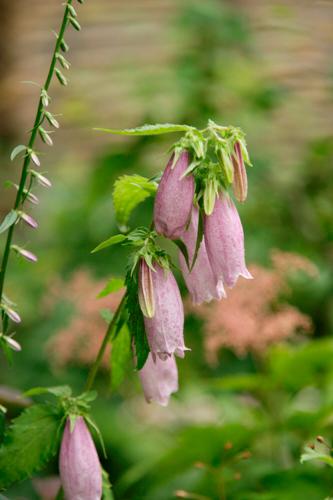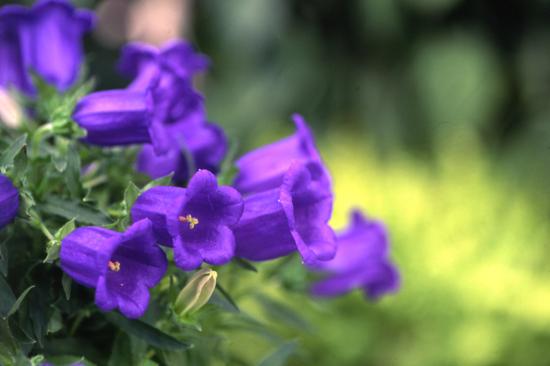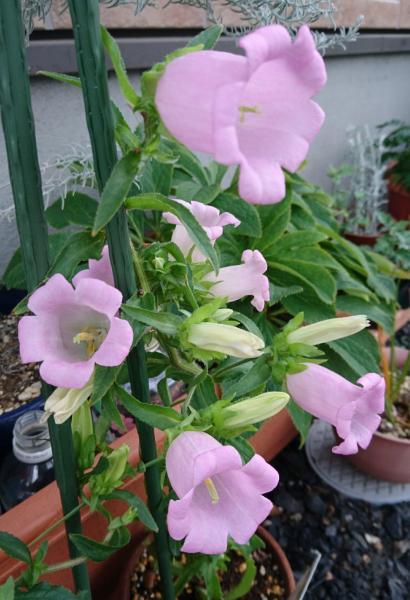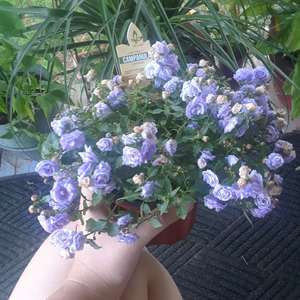文章
Miss Chen
2018年09月05日

Bluebells (Campanula rotundifolia) grow naturally in wooded areas. In the United States they have become a favorite among wildflower lovers. The bluebell is easy to care for and spreads rapidly under the right conditions. This flower is a favorite of hummingbirds because of the shape of its blooms. The flowers are long and narrow, creating the perfect cup for a hummingbird to take nectar from.

Bell-Shaped Flowers
Native to England and Scotland, bluebell is a perennial plant named for the shape of the flower which looks like a tiny bell. These flowers grow in clusters and are usually, but not always, blue as the name implies. Bluebells can be a creamy, off-white color. The cream-colored bluebell is rarely found in nature. This plant has long stems and narrow leaves. It grows to be 12 to 18 inches tall.
Flexiblity for Garden Uses
Because bluebells are native to a range of habitats, including meadows, rocky hillsides, sandy soils and rocky crevices, they work well in many types of gardens. Tuck them into the small openings of a rock wall or among other small plants in a rock garden. Or plant them in a lightly shaded woodland area of your yard where they will multiply and naturalize to form a mass of bright blue in the late spring and throughout the summer. Moreover, bluebells attract hummingbirds wherever you plant them.
Growing Bluebells
Bluebells are common in wooded areas of Scotland, England and the United States, where they grow in USDA zones 3 to 8. They are grown from bulbs, which can endure frosts and hot temperatures. Plant the bulbs 2 inches underground in the fall, before the first frost. Plant bluebells at least 12 inches apart. The bluebell prefers partial sun with some shade in the afternoon. They do well when planted with ferns and other woodland plants. These plants do best when kept moist, so water them daily. Bluebells are useful for keeping the pest nematodes under control.

Propagation for More Plants
Bluebells are rapidly spreading perennials. As perennials, they will return each spring. As they return, they spread in clumps and choke out nearby vegetation if they are not divided every two or three years. Divide plants that are outgrowing their space in the garden. Divide the plants in fall. Place plant divisions in the ground before the threat of frost. Place 2 inches of manure over bulbs in the fall to ensure healthy plants the following spring.

Bell-Shaped Flowers
Native to England and Scotland, bluebell is a perennial plant named for the shape of the flower which looks like a tiny bell. These flowers grow in clusters and are usually, but not always, blue as the name implies. Bluebells can be a creamy, off-white color. The cream-colored bluebell is rarely found in nature. This plant has long stems and narrow leaves. It grows to be 12 to 18 inches tall.
Flexiblity for Garden Uses
Because bluebells are native to a range of habitats, including meadows, rocky hillsides, sandy soils and rocky crevices, they work well in many types of gardens. Tuck them into the small openings of a rock wall or among other small plants in a rock garden. Or plant them in a lightly shaded woodland area of your yard where they will multiply and naturalize to form a mass of bright blue in the late spring and throughout the summer. Moreover, bluebells attract hummingbirds wherever you plant them.
Growing Bluebells
Bluebells are common in wooded areas of Scotland, England and the United States, where they grow in USDA zones 3 to 8. They are grown from bulbs, which can endure frosts and hot temperatures. Plant the bulbs 2 inches underground in the fall, before the first frost. Plant bluebells at least 12 inches apart. The bluebell prefers partial sun with some shade in the afternoon. They do well when planted with ferns and other woodland plants. These plants do best when kept moist, so water them daily. Bluebells are useful for keeping the pest nematodes under control.

Propagation for More Plants
Bluebells are rapidly spreading perennials. As perennials, they will return each spring. As they return, they spread in clumps and choke out nearby vegetation if they are not divided every two or three years. Divide plants that are outgrowing their space in the garden. Divide the plants in fall. Place plant divisions in the ground before the threat of frost. Place 2 inches of manure over bulbs in the fall to ensure healthy plants the following spring.
0
0
文章
Dummer. ゛☀
2017年10月08日

There is enough diversity in the bellflower or Campanula clan to ring just about any gardener's chimes. With bell-shaped, tubular or star-shaped flowers in shades of blue, white, pink and red, they have growth habits that range from low and creeping to tall and upright. Most of the garden-worthy choices are perennials, although there are some annuals and a biennial in the genus. And all are beautiful, even the few that are such vigorous spreaders and seeders that you may need to think twice about including them in your garden.

About bellflowers
Bellflowers are hardy plants, with most types growing in Zones 4 to 8, even to zone 3 with reliable snow cover to provide insulation, but they'll sulk in the heat of the Deep South or Southwest. Peak bloom is in early to midsummer for most, but with deadheading you may get sporadic bloom throughout the summer and a second flush of flowers in fall. Bellflowers look lovely in many garden settings; their showy flowers and informal habit are the perfect fit in a cottage garden.
Special features of bellflowers
Bellflowers fall into two categories, tall, upright growers that are good choices for a border or for cutting, and low growers that work well for edging or in rock gardens.
One of the most popular uprights is Peach Leaved Bellflower (Campanula persicifolia). Tall, 15 to 30 inch spikes of 1-1.5 inch, broadly bell-shaped flowers in shades of blue, pink, white and purple rise in early summer from basal clumps of leaves. Clustered bellflower (C. glomerata) produces upwards facing heads of blossoms in purple or white in early summer on sturdy 18 inch stems. Milky bellflower (C. lactiflora), 3 to 5 feet tall, and great bellflower (C. latifolia), 4 to 5 feet tall, also both have upward-facing flowers.
Other upright growers are distinguished by their large, nodding blossoms. Spotted bellflower (C. punctata) gets about 2 feet tall and bears pink, speckled, dangling flowers from midsummer to fall. 'Cherry Bells' is a popular cultivar. The hybrid 'Sarastro' has large, deep-purple, nodding bells on a 2.5 to 3 foot tall plant.
The low spreading bellflowers look nice trailing over the tops and between the stones of a dry rock wall. In early summer, Serbian Bellflower (C. poscharskyana) spreads a wave of blue, 1-1", star-shaped flowers. Adriatic bellflower (C. garganica) and Dalmatian bellflower (C. portenschlagiana) are similar. For edging along a path, the low growing Carpathian harebell (C. carpatica) is perfect. The cultivar 'Blue Clips' bears bright blue bells on 8-12" high plants over most of the summer. Even more floriferous is the sterile hybrid 'Samantha', which is covered in violet-blue, bowl-shaped blossoms above a 6" high clump of leaves.
The biennial Canterbury bells (C. medium) is an old fashioned favorite, growing 12 to 30 inches tall and sporting boxy, bell-shaped flowers in shades of lilac, blue, pink and white. Start these plants from seed in midsummer for bloom the following year.

Choosing a site to grow bellflowers
Most bellflowers do best if planted in full sun, but will also thrive in light shade. Plant in moist, well-drained soil that is high in organic matter. Some are spreaders, especially clustered bellflower and Serbian bellflower, so plant these where they'll have some room to roam. But steer clear of the aggressive Korean bellflower (C. rapunculoides) which spreads so readily, it can become invasive.
Planting Instructions
Container plants can be set out any time during the growing season. Space most plants about a foot apart; the tall milky bellflower should have 24 inch spacing. Prepare the garden bed by using a garden fork or tiller to loosen the soil to a depth of 12 to 15 inches, then mix in a 2- to 4-inch layer of compost. Dig a hole twice the diameter of the pot the plant is in. Carefully remove the plant from its container and place it in the hole so the top of the root ball is level with the soil surface. Carefully fill in around the root ball and firm the soil gently. Water thoroughly.

Ongoing Care
Apply a complete organic fertilizer and a thin layer of compost each spring, followed by a 2-inch layer of mulch to retain moisture and control weeds. Water plants during the summer if rainfall is less than 1 inch per week. Deadhead flowers to neaten plants and prevent self-sowing. On taller types, remove faded flowers individually, then cut back the flowering stalks to the base when all bloom is finished. With low growers, wait until the first flush of bloom is past, then shear back plants by half. Peachleaf bellflower can self-sow to the point of weediness if not deadheaded. Most bellflowers benefit from division every 3 to 5 years to keep them growing vigorously.

About bellflowers
Bellflowers are hardy plants, with most types growing in Zones 4 to 8, even to zone 3 with reliable snow cover to provide insulation, but they'll sulk in the heat of the Deep South or Southwest. Peak bloom is in early to midsummer for most, but with deadheading you may get sporadic bloom throughout the summer and a second flush of flowers in fall. Bellflowers look lovely in many garden settings; their showy flowers and informal habit are the perfect fit in a cottage garden.
Special features of bellflowers
Bellflowers fall into two categories, tall, upright growers that are good choices for a border or for cutting, and low growers that work well for edging or in rock gardens.
One of the most popular uprights is Peach Leaved Bellflower (Campanula persicifolia). Tall, 15 to 30 inch spikes of 1-1.5 inch, broadly bell-shaped flowers in shades of blue, pink, white and purple rise in early summer from basal clumps of leaves. Clustered bellflower (C. glomerata) produces upwards facing heads of blossoms in purple or white in early summer on sturdy 18 inch stems. Milky bellflower (C. lactiflora), 3 to 5 feet tall, and great bellflower (C. latifolia), 4 to 5 feet tall, also both have upward-facing flowers.
Other upright growers are distinguished by their large, nodding blossoms. Spotted bellflower (C. punctata) gets about 2 feet tall and bears pink, speckled, dangling flowers from midsummer to fall. 'Cherry Bells' is a popular cultivar. The hybrid 'Sarastro' has large, deep-purple, nodding bells on a 2.5 to 3 foot tall plant.
The low spreading bellflowers look nice trailing over the tops and between the stones of a dry rock wall. In early summer, Serbian Bellflower (C. poscharskyana) spreads a wave of blue, 1-1", star-shaped flowers. Adriatic bellflower (C. garganica) and Dalmatian bellflower (C. portenschlagiana) are similar. For edging along a path, the low growing Carpathian harebell (C. carpatica) is perfect. The cultivar 'Blue Clips' bears bright blue bells on 8-12" high plants over most of the summer. Even more floriferous is the sterile hybrid 'Samantha', which is covered in violet-blue, bowl-shaped blossoms above a 6" high clump of leaves.
The biennial Canterbury bells (C. medium) is an old fashioned favorite, growing 12 to 30 inches tall and sporting boxy, bell-shaped flowers in shades of lilac, blue, pink and white. Start these plants from seed in midsummer for bloom the following year.

Choosing a site to grow bellflowers
Most bellflowers do best if planted in full sun, but will also thrive in light shade. Plant in moist, well-drained soil that is high in organic matter. Some are spreaders, especially clustered bellflower and Serbian bellflower, so plant these where they'll have some room to roam. But steer clear of the aggressive Korean bellflower (C. rapunculoides) which spreads so readily, it can become invasive.
Planting Instructions
Container plants can be set out any time during the growing season. Space most plants about a foot apart; the tall milky bellflower should have 24 inch spacing. Prepare the garden bed by using a garden fork or tiller to loosen the soil to a depth of 12 to 15 inches, then mix in a 2- to 4-inch layer of compost. Dig a hole twice the diameter of the pot the plant is in. Carefully remove the plant from its container and place it in the hole so the top of the root ball is level with the soil surface. Carefully fill in around the root ball and firm the soil gently. Water thoroughly.

Ongoing Care
Apply a complete organic fertilizer and a thin layer of compost each spring, followed by a 2-inch layer of mulch to retain moisture and control weeds. Water plants during the summer if rainfall is less than 1 inch per week. Deadhead flowers to neaten plants and prevent self-sowing. On taller types, remove faded flowers individually, then cut back the flowering stalks to the base when all bloom is finished. With low growers, wait until the first flush of bloom is past, then shear back plants by half. Peachleaf bellflower can self-sow to the point of weediness if not deadheaded. Most bellflowers benefit from division every 3 to 5 years to keep them growing vigorously.
1
0
文章
玲儿
2017年09月20日

モモバギキョウの基本情報
学名:Campanula persicifolia (C.nitida,C.planiflora)
和名:モモバギキョウ(桃葉桔梗) その他の名前:モモノハギキョウ
科名 / 属名:キキョウ科 / ホタルブクロ属
特徴
モモバギキョウは宿根草としてよく知られる多年草です。林縁や森林内の開けた場所、牧草地に自生します。古くから栽培されてきたため、数多くの園芸品種があります。ヨーロッパでは標準的な宿根草で、日本への紹介も古いのですが、いまひとつ普及していません。

高さ30~90cm、茎は直立して株立ちになります。茎の先端に10数輪の釣り鐘形の花を横向きか、やや上向きに咲かせます。花色は白から青紫色まで幅があります。葉は細長くて根元から茎の中ほどまで多数つきます。和名は葉が果樹のモモの葉に似ていることからつけられました。
普通の草花を育てるような土でも生育しますが、夏が暑い日本の多くの地域では短命に終わりがちなので、水はけのよい土にすることをすすめます。

種類(原種、園芸品種)
‘ニチダ’
Campanula persicifolia ‘Nitida’
モモバギキョウの矮性品種で、草丈15cm前後になる。栽培上は高山植物として扱う。
‘ニチダ・アルバ’
Campanula persicifolia ‘Nitida Alba’
‘ニチダ’の白花タイプ。扱いは‘ニチダ’と同じ。
カンパニュラ・ラティロバ
Campanula latiloba
高さ1m前後、茎はまっすぐで株立ちになる。茎先に花柄のない花が密集して花穂となる。原産地はトルコ北部の草原。
カンパニュラ・トラケリウム
Campanula trachelium
高さ1m前後で、株立ちになる。茎の先端や上部の葉のわきに、長さ3cm前後の釣り鐘形の花を咲かせる。原産地はヨーロッパから中近東、北アフリカ、西シベリア。
カンパニュラ・アリアリーフォリア
Campanula alliariifolia
ホタルブクロに似た種で、高さ40〜70cm、株立ちになる。花は白く釣り鐘形で長さ4cmほど。コーカサス地方原産。
カンパニュラ・ラプンクロイデス
Campanula rapunculoides
高さ100〜150cm、茎先は花穂となり、長さ2cmほどの花が下向きにつく。原産地はヨーロッパから東シベリア。走出茎を伸ばしてふえる。

学名:Campanula persicifolia (C.nitida,C.planiflora)
和名:モモバギキョウ(桃葉桔梗) その他の名前:モモノハギキョウ
科名 / 属名:キキョウ科 / ホタルブクロ属
特徴
モモバギキョウは宿根草としてよく知られる多年草です。林縁や森林内の開けた場所、牧草地に自生します。古くから栽培されてきたため、数多くの園芸品種があります。ヨーロッパでは標準的な宿根草で、日本への紹介も古いのですが、いまひとつ普及していません。

高さ30~90cm、茎は直立して株立ちになります。茎の先端に10数輪の釣り鐘形の花を横向きか、やや上向きに咲かせます。花色は白から青紫色まで幅があります。葉は細長くて根元から茎の中ほどまで多数つきます。和名は葉が果樹のモモの葉に似ていることからつけられました。
普通の草花を育てるような土でも生育しますが、夏が暑い日本の多くの地域では短命に終わりがちなので、水はけのよい土にすることをすすめます。

種類(原種、園芸品種)
‘ニチダ’
Campanula persicifolia ‘Nitida’
モモバギキョウの矮性品種で、草丈15cm前後になる。栽培上は高山植物として扱う。
‘ニチダ・アルバ’
Campanula persicifolia ‘Nitida Alba’
‘ニチダ’の白花タイプ。扱いは‘ニチダ’と同じ。
カンパニュラ・ラティロバ
Campanula latiloba
高さ1m前後、茎はまっすぐで株立ちになる。茎先に花柄のない花が密集して花穂となる。原産地はトルコ北部の草原。
カンパニュラ・トラケリウム
Campanula trachelium
高さ1m前後で、株立ちになる。茎の先端や上部の葉のわきに、長さ3cm前後の釣り鐘形の花を咲かせる。原産地はヨーロッパから中近東、北アフリカ、西シベリア。
カンパニュラ・アリアリーフォリア
Campanula alliariifolia
ホタルブクロに似た種で、高さ40〜70cm、株立ちになる。花は白く釣り鐘形で長さ4cmほど。コーカサス地方原産。
カンパニュラ・ラプンクロイデス
Campanula rapunculoides
高さ100〜150cm、茎先は花穂となり、長さ2cmほどの花が下向きにつく。原産地はヨーロッパから東シベリア。走出茎を伸ばしてふえる。

0
0
文章
玲儿
2017年09月19日

ホタルブクロの基本情報
学名:Campanula punctata var. punctata
和名:ホタルブクロ(蛍袋) その他の名前:チョウチンバナ、トッカンバナ
科名 / 属名:キキョウ科 / ホタルブクロ属
特徴
ホタルブクロは、各地の平地から山地に広く分布する多年草です。日当たりのよい草原や、林縁などで多く見られます。初夏から夏の前半にかけて釣り鐘形の花を茎に多数咲かせます。細い地下茎を伸ばしてふえ、開花した株はタネと多数の子株を残して枯れます。子株は1~2年で親株になります。丈夫で、あまり手のかからない植物です。

朝鮮半島に分布し、似たような姿で毛が少なく光沢のある厚い葉と鋭い鋸歯(きょし)が特徴のカンパヌラ・タケシマナ(Campanula takesimana)や、紫色の花をつけ「紫ホタルブクロ」や「青花ホタルブクロ」の名で流通している‘サラストロ’(C. ‘Sarastro’)や‘ケント・ベル’(C. ‘Kent Belle’)も同様に扱えます。

種類(原種、園芸品種)
カンパヌラ・タケシマナ‘ビューティフル・トラスト’
Campanula takesimana ‘Beautiful Trust’
白花で袋が裂けた采咲きの園芸品種。葉も細い。多くの場合「白糸ホタルブクロ」の名で流通している。
カンパヌラ‘ケント・ベル’
Campanula takesimana ‘Kent Belle’
タケシマナとカンパヌラ・ラティフォリアの交配種で、鮮やかな紫色の花を咲かせる。多くの場合‘サラストロ’と一緒くたにして「紫ホタルブクロ」や「青花ホタルブクロ」の名で流通している。

学名:Campanula punctata var. punctata
和名:ホタルブクロ(蛍袋) その他の名前:チョウチンバナ、トッカンバナ
科名 / 属名:キキョウ科 / ホタルブクロ属
特徴
ホタルブクロは、各地の平地から山地に広く分布する多年草です。日当たりのよい草原や、林縁などで多く見られます。初夏から夏の前半にかけて釣り鐘形の花を茎に多数咲かせます。細い地下茎を伸ばしてふえ、開花した株はタネと多数の子株を残して枯れます。子株は1~2年で親株になります。丈夫で、あまり手のかからない植物です。

朝鮮半島に分布し、似たような姿で毛が少なく光沢のある厚い葉と鋭い鋸歯(きょし)が特徴のカンパヌラ・タケシマナ(Campanula takesimana)や、紫色の花をつけ「紫ホタルブクロ」や「青花ホタルブクロ」の名で流通している‘サラストロ’(C. ‘Sarastro’)や‘ケント・ベル’(C. ‘Kent Belle’)も同様に扱えます。

種類(原種、園芸品種)
カンパヌラ・タケシマナ‘ビューティフル・トラスト’
Campanula takesimana ‘Beautiful Trust’
白花で袋が裂けた采咲きの園芸品種。葉も細い。多くの場合「白糸ホタルブクロ」の名で流通している。
カンパヌラ‘ケント・ベル’
Campanula takesimana ‘Kent Belle’
タケシマナとカンパヌラ・ラティフォリアの交配種で、鮮やかな紫色の花を咲かせる。多くの場合‘サラストロ’と一緒くたにして「紫ホタルブクロ」や「青花ホタルブクロ」の名で流通している。

0
0
文章
Dummer. ゛☀
2017年08月09日

This slender, delicate wildflower was known as the bluebell in some parts of Scotland, but most people in Britain and Ireland who know their wildflowers call it the Harebell.
Identification
Campanula rotundifoila is a hairless perennial that copes well with drought and exposure to sun and wind, but as a result its height is very variable and ranges from a mere 15cm to 40cm and occasionally more.
The short-lived basal leaves are round and have long stalks; leaves higher on the stems are narrower and stemless, persisting throughout the blooming period. The delicate nodding blue flowers, borne on short slender stalks, are bell shaped with nearly always five fused out-curved petals creating a toothed corolla 12 to 25mm long.
Distribution
Campanula rotundifolia is common and widespread throughout Britain and occurs in many parts of Ireland particularly along the western and northern coasts. This wildlfower is also found in many parts of mainland Europe and in North America.
Habitat
Harebells are found in both acid and alkaline sites, but they favour dry grassy situations such as coastal sand-dune systems and the edges of pine woodland on sandy soils.
Harebells grow in great abundance and make spectacular displays on banks, under sparse hedgerows and on well drained slopes in the hills of Britain and Ireland.
Blooming Times
In Britain and Ireland the first Harebells bloom in late June or early July and continue flowering through to the end of October and occasionally, if the weather is not too harsh, well in to November. Although late arrivals, therefore, these pretty little flowers add a welcome splash of colour to the countryside in late summer, just as most other wildflowers are dying back.
Etymology
Campanula, the genus name, referes to the campanulate (bell-like) form of the flowers, while the specific epithet rotundifolia means with round (in other words rotund!) leaves.
Uses
Although it has in the past been used to treat various ailments, there is surprisingly little reference to Harebells as a herbal remedy. Perhaps some flowers really are best enjoyed for their beauty... unless you are a bee, in which case you will not be alone in visiting Harebells.
Identification
Campanula rotundifoila is a hairless perennial that copes well with drought and exposure to sun and wind, but as a result its height is very variable and ranges from a mere 15cm to 40cm and occasionally more.

The short-lived basal leaves are round and have long stalks; leaves higher on the stems are narrower and stemless, persisting throughout the blooming period. The delicate nodding blue flowers, borne on short slender stalks, are bell shaped with nearly always five fused out-curved petals creating a toothed corolla 12 to 25mm long.
Distribution
Campanula rotundifolia is common and widespread throughout Britain and occurs in many parts of Ireland particularly along the western and northern coasts. This wildlfower is also found in many parts of mainland Europe and in North America.

Habitat
Harebells are found in both acid and alkaline sites, but they favour dry grassy situations such as coastal sand-dune systems and the edges of pine woodland on sandy soils.
Harebells grow in great abundance and make spectacular displays on banks, under sparse hedgerows and on well drained slopes in the hills of Britain and Ireland.
Blooming Times
In Britain and Ireland the first Harebells bloom in late June or early July and continue flowering through to the end of October and occasionally, if the weather is not too harsh, well in to November. Although late arrivals, therefore, these pretty little flowers add a welcome splash of colour to the countryside in late summer, just as most other wildflowers are dying back.
Etymology
Campanula, the genus name, referes to the campanulate (bell-like) form of the flowers, while the specific epithet rotundifolia means with round (in other words rotund!) leaves.

Uses
Although it has in the past been used to treat various ailments, there is surprisingly little reference to Harebells as a herbal remedy. Perhaps some flowers really are best enjoyed for their beauty... unless you are a bee, in which case you will not be alone in visiting Harebells.
0
0
文章
玲儿
2017年07月26日

カンパニュラ・メディウムの基本情報
学名:Campanula medium
和名:フウリンソウ(風鈴草) その他の名前:カンタベリー・ベルズ(Canterbury bells)
科名 / 属名:キキョウ科 / ホタルブクロ属
特徴
カンパニュラ・メディウムは、ヨーロッパでは古くから栽培されてきた植物です。野生種はフランス南東部からイタリア半島中部に分布し、標高0~1500mの日当たりのよい岩場に見られます。
葉はタンポポのように地面に張りつくように広がり、やがてその中心から花茎がまっすぐに伸びます。花茎は上部で枝分かれし、それぞれの先に長さ5~7cmの釣り鐘形の花を上向きに咲かせます。花色は白、ピンク、紫と多彩です。咲き終わると果実が実り、タネを残して株は完全に枯れます。
花が咲くには、十分な大きさに育った株が冬の寒さに当たることが必要でしたが、最近では寒さに当てなくても開花する園芸品種がつくり出されています。
萼が変化して二重咲きになり、外側の花びらが平らに開くものは、「カップ・アンド・ソーサー」と呼ばれています。これは変種カリカンセマ(Campanula medium var.calycanthema)で、これにもいろいろな花色があります。ほかにも多数の園芸品種があります。

育て方のポイント
栽培環境・日当たり・置き場
風通しのよい日なたで育てます。日陰では育ちません。庭植えの場合は、土を20~30cm盛り上げたところに植えます。土には完熟堆肥を混ぜて水はけをよくし、さらに石灰を混ぜて中性~弱アルカリ性にします。
水やり
鉢植えは表土が乾いたら十分に与えます。庭植えの場合は、晴天が続いてよほど乾燥しないかぎり必要ありません。
肥料
小苗を植えつけるときに、三要素等量配合の緩効性化成肥料を3号鉢相当の株で一つまみ、元肥として施します。その後、冬を除く生育期間中に月2~3回、草花用の液体肥料を1500~2000倍に薄めて施します。鉢、または花壇への定植時に、元肥として三要素等量配合の緩効性化成肥料を3号鉢相当の株で一つまみ施します。

病気と害虫
病気:菌核病、斑点病、白絹病、根腐病、灰色かび病
6月から9月に発生する菌核病や根腐病、一年中発生することもある斑点病や褐斑細菌病、5月から9月に発生する白絹病は、株が枯れることがあります。感染した株は根ごと取り除きます。風通しと水はけをよくすると発病を抑えることができます。白絹病の場合は放置すると病原菌が土中で長期間生きて、毎年発病を繰り返します。
害虫:ヨトウムシ
ヨトウムシはヨトウガの幼虫で、葉を暴食します。主に晩春から初夏と、初秋の2回を中心に発生します。温暖な都市部では一年中見られることもあります。

用土(鉢植え)
腐植質の混ざった水はけのよい土に石灰類を混ぜ、用土を中性から弱アルカリ性に中和して使います。市販の草花用培養土に石灰類を混ぜると、使い勝手がよく手軽です。
植えつけ、 植え替え
タネをまいた場合、発芽して本葉2~3枚の時期に3号ポットに鉢上げします。成長した苗は9月から10月上旬に、鉢か花壇に定植します。移植の際に根を傷つけないように注意しましょう。

ふやし方
タネまき:6月から7月にまきます。タネまきが遅れると、翌年に開花可能な株に育ちきらないまま冬を迎えてしまうので、必ず適期を守りましょう。タネは市販のタネまき用の用土のような清潔な土にまきます。赤玉土小粒に熱湯を注いで消毒したものでも問題ありません。密にまきすぎないように注意しましょう。
主な作業
支柱立て:花茎が伸び始めたら、支柱を立てて倒れないように支えます。
学名:Campanula medium
和名:フウリンソウ(風鈴草) その他の名前:カンタベリー・ベルズ(Canterbury bells)
科名 / 属名:キキョウ科 / ホタルブクロ属
特徴
カンパニュラ・メディウムは、ヨーロッパでは古くから栽培されてきた植物です。野生種はフランス南東部からイタリア半島中部に分布し、標高0~1500mの日当たりのよい岩場に見られます。
葉はタンポポのように地面に張りつくように広がり、やがてその中心から花茎がまっすぐに伸びます。花茎は上部で枝分かれし、それぞれの先に長さ5~7cmの釣り鐘形の花を上向きに咲かせます。花色は白、ピンク、紫と多彩です。咲き終わると果実が実り、タネを残して株は完全に枯れます。
花が咲くには、十分な大きさに育った株が冬の寒さに当たることが必要でしたが、最近では寒さに当てなくても開花する園芸品種がつくり出されています。
萼が変化して二重咲きになり、外側の花びらが平らに開くものは、「カップ・アンド・ソーサー」と呼ばれています。これは変種カリカンセマ(Campanula medium var.calycanthema)で、これにもいろいろな花色があります。ほかにも多数の園芸品種があります。

育て方のポイント
栽培環境・日当たり・置き場
風通しのよい日なたで育てます。日陰では育ちません。庭植えの場合は、土を20~30cm盛り上げたところに植えます。土には完熟堆肥を混ぜて水はけをよくし、さらに石灰を混ぜて中性~弱アルカリ性にします。
水やり
鉢植えは表土が乾いたら十分に与えます。庭植えの場合は、晴天が続いてよほど乾燥しないかぎり必要ありません。
肥料
小苗を植えつけるときに、三要素等量配合の緩効性化成肥料を3号鉢相当の株で一つまみ、元肥として施します。その後、冬を除く生育期間中に月2~3回、草花用の液体肥料を1500~2000倍に薄めて施します。鉢、または花壇への定植時に、元肥として三要素等量配合の緩効性化成肥料を3号鉢相当の株で一つまみ施します。

病気と害虫
病気:菌核病、斑点病、白絹病、根腐病、灰色かび病
6月から9月に発生する菌核病や根腐病、一年中発生することもある斑点病や褐斑細菌病、5月から9月に発生する白絹病は、株が枯れることがあります。感染した株は根ごと取り除きます。風通しと水はけをよくすると発病を抑えることができます。白絹病の場合は放置すると病原菌が土中で長期間生きて、毎年発病を繰り返します。
害虫:ヨトウムシ
ヨトウムシはヨトウガの幼虫で、葉を暴食します。主に晩春から初夏と、初秋の2回を中心に発生します。温暖な都市部では一年中見られることもあります。

用土(鉢植え)
腐植質の混ざった水はけのよい土に石灰類を混ぜ、用土を中性から弱アルカリ性に中和して使います。市販の草花用培養土に石灰類を混ぜると、使い勝手がよく手軽です。
植えつけ、 植え替え
タネをまいた場合、発芽して本葉2~3枚の時期に3号ポットに鉢上げします。成長した苗は9月から10月上旬に、鉢か花壇に定植します。移植の際に根を傷つけないように注意しましょう。

ふやし方
タネまき:6月から7月にまきます。タネまきが遅れると、翌年に開花可能な株に育ちきらないまま冬を迎えてしまうので、必ず適期を守りましょう。タネは市販のタネまき用の用土のような清潔な土にまきます。赤玉土小粒に熱湯を注いで消毒したものでも問題ありません。密にまきすぎないように注意しましょう。
主な作業
支柱立て:花茎が伸び始めたら、支柱を立てて倒れないように支えます。
0
0






